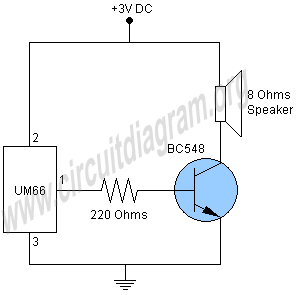
door bell circuit

This project involves a simple doorbell circuit featuring the UM66 melody integrated circuit (IC), which is well-known for its melody generation capabilities. The IC is housed in a TO-92 transistor package and consists of only three pins, functioning as a complete melody system that requires no external components. It operates with a 3-volt battery of any size and a small piezo speaker to produce a pleasant melody. The UM66 IC is available in various melodies. Additionally, a BC 548 transistor is utilized to amplify the output of the IC, enabling it to drive an 8-ohm speaker.
The doorbell circuit primarily relies on the UM66 melody IC, which is designed for simplicity and efficiency in melody playback. The circuit's configuration allows it to operate directly from a 3-volt power source, making it suitable for battery operation. The three pins of the UM66 include power supply, ground, and output, which simplifies the circuit design and minimizes the need for additional components.
The piezo speaker serves as the sound output device, converting the electrical signals from the UM66 into audible sound. The choice of a small piezo speaker ensures that the circuit remains compact while still delivering clear sound quality. The BC 548 transistor plays a crucial role in enhancing the output signal from the UM66, allowing it to drive an 8-ohm speaker effectively. This amplification is essential for achieving sufficient sound levels for the doorbell application.
In terms of assembly, the circuit can be constructed on a small breadboard or PCB, with careful attention to the connections between the UM66, the transistor, and the speaker. Proper decoupling of the power supply may be considered to ensure stable operation of the circuit. The overall design is straightforward, making it an excellent project for beginners in electronics, while also providing a functional and enjoyable doorbell solution.Here is a very simple project of a door bell circuit. The heart of the circuit is UM66 melody IC which is a great and very famous melody IC, comes in TO-92 transistor package. The IC has only three pins and it is a complete melody system requires no external components only connect 3 volt batteries (any size) and a small piezo and it will start g
enerating pleasing melody. Now a days this IC comes in variety of different melodies. The transistor BC 548 is used to amplify the output of the IC to drive an 8 ohms speaker. 🔗 External reference
The doorbell circuit primarily relies on the UM66 melody IC, which is designed for simplicity and efficiency in melody playback. The circuit's configuration allows it to operate directly from a 3-volt power source, making it suitable for battery operation. The three pins of the UM66 include power supply, ground, and output, which simplifies the circuit design and minimizes the need for additional components.
The piezo speaker serves as the sound output device, converting the electrical signals from the UM66 into audible sound. The choice of a small piezo speaker ensures that the circuit remains compact while still delivering clear sound quality. The BC 548 transistor plays a crucial role in enhancing the output signal from the UM66, allowing it to drive an 8-ohm speaker effectively. This amplification is essential for achieving sufficient sound levels for the doorbell application.
In terms of assembly, the circuit can be constructed on a small breadboard or PCB, with careful attention to the connections between the UM66, the transistor, and the speaker. Proper decoupling of the power supply may be considered to ensure stable operation of the circuit. The overall design is straightforward, making it an excellent project for beginners in electronics, while also providing a functional and enjoyable doorbell solution.Here is a very simple project of a door bell circuit. The heart of the circuit is UM66 melody IC which is a great and very famous melody IC, comes in TO-92 transistor package. The IC has only three pins and it is a complete melody system requires no external components only connect 3 volt batteries (any size) and a small piezo and it will start g
enerating pleasing melody. Now a days this IC comes in variety of different melodies. The transistor BC 548 is used to amplify the output of the IC to drive an 8 ohms speaker. 🔗 External reference





